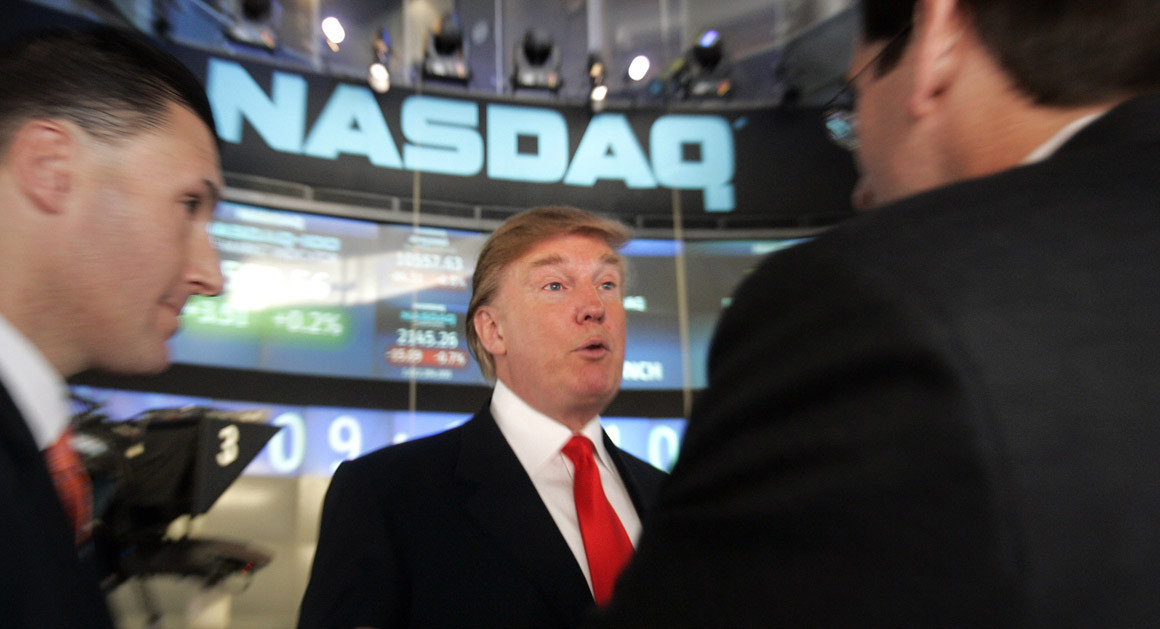Economy
Rising Tensions in Hong Kong May Lead to Pullback on Wall Street

By Investors Hub
The major U.S. index futures are currently pointing to a lower opening on Friday, with stocks likely to move back to the downside after trending higher in recent sessions.
Rising tensions in Hong Kong may weigh on Wall Street amid concerns widespread protests could impact the ability of the U.S. and China to reach a phase on trade deal.
Traders may also look to take some profits after the upward trend see over the past several sessions lifted the major averages to new record highs.
However, the markets have recently shown a resistance to giving back much ground, with traders seemingly concerned about missing out on further upside.
Overall trading activity is likely to remain subdued, as some traders to the sidelines following the holiday on Thursday.
A lack of major U.S. economic news may also contribute to light trading activity along with the early close for the markets.
Extending the upward trend seen over the past few sessions, stocks moved mostly higher over the course of the trading day on Wednesday. Buying interest was somewhat subdued, but the major averages still managed to reach new record closing highs.
The major averages all closed in positive territory, with the Nasdaq and the S&P 500 just off their highs of the session. The Dow rose 42.32 points or 0.2 percent to 28,164.00, the Nasdaq advanced 57.24 points or 0.7 percent to 8,705.18 and the S&P 500 climbed 13.11 points or 0.4 percent to 3,153.63.
The markets continued to benefit from optimism about a potential U.S.-China trade deal after President Donald Trump said trade talks are “going very well.”
“We’re in the final throes of a very important deal ? I guess you could say, one of the most important deals in trade ever,” Trump told reporters at the White House on Tuesday.
The continued strength on Wall Street also came following the release of some upbeat U.S. economic data, including a Commerce Department report showing durable goods orders unexpectedly rebounded in the month of October.
The Commerce Department said durable goods orders climbed by 0.6 percent in October after plunging by a revised 1.4 percent in September.
Economists had expected durable goods orders to decrease by 0.8 percent compared to the 1.2 percent slump that had been reported for the previous month.
Separately, revised data released by the Commerce Department showed the U.S. economy grew by more than initially estimated in the third quarter.
The Commerce Department said real gross domestic product jumped by 2.1 percent in the third quarter compared to the previously estimated 1.9 percent increase. Economists had expected the pace of GDP growth to be unrevised.
The stronger than previous estimated growth reflected upward revisions to private inventory investment, non-residential fixed investment, and consumer spending.
Meanwhile, the National Association of Realtors released a report unexpectedly showing a sharp pullback in U.S. pending home sales in the month of October.
NAR said its pending home sales index plunged by 1.7 percent to 106.7 in October after surging up by 1.4 percent to a revised 108.6 in September.
Economists had expected pending home sales to climb by 0.8 percent compared to the 1.5 percent jump originally reported for the previous month.
A pending home sale is one in which a contract was signed but not yet closed. Normally, it takes four to six weeks to close a contracted sale.
The Commerce Department also released a separate report showing U.S. personal income came in nearly flat in the month of October, although personal spending rose in line with economist estimates.
Late in the trading day, the Federal Reserve released its Beige Book, which said U.S. economic activity expanded modestly from October through mid-November.
The Beige Book, a compilation of anecdotal evidence on economic conditions in the twelve Fed districts, noted economic growth continued at a similar pace to the prior reporting period.
Trading activity was relatively light, however, as some traders looked to get a head start on the Thanksgiving Day holiday on Thursday.
Oil service stocks moved sharply higher over the course of the trading session, driving the Philadelphia Oil Service Index up by 2 percent. The strength among oil service stocks came despite a decrease by the price of crude oil.
Significant strength was also visible among tobacco stocks, with the NYSE Arca Tobacco Index climbing by 1.2 percent to its best closing level in over two months.
Natural gas and biotechnology stocks also saw considerable strength on the day, while most of the other major sectors showed more modest moves.
Economy
NBA Demands Suspension of Controversial Tax Laws

By Modupe Gbadeyanka
The federal government has been asked by the Nigerian Bar Association (NBA) to suspend the implementation of the controversial tax laws.
In a reaction to the tax reform acts, the president of the group, Mr Afam Osigwe (SAN), the suspension of the laws would allow for a proper investigation into allegations of alterations in the gazetted and harmonised copies.
A member of the House of Representatives, Mr Abdussamad Dasuki, alleged that some parts of the laws passed by the parliament were different from the gazetted copy.
To address the issues raised, the NBA said it is “imperative that a comprehensive, open, and transparent investigation be conducted to clarify the circumstances surrounding the enactment of the laws and to restore public confidence in the legislative process.”
“Until these issues are fully examined and resolved, all plans for the implementation of the Tax Reform Acts should be immediately suspended,” the association declared.
It noted that the controversies “raise grave concerns about the integrity, transparency, and credibility of Nigeria’s legislative process.”
“These developments strike at the very heart of constitutional governance and call into question the procedural sanctity that must attend lawmaking in a democratic society,” it noted.
“Legal and policy uncertainty of this magnitude has far-reaching consequences. It unsettles the business environment, erodes investor confidence, and creates unpredictability for individuals, businesses, and institutions required to comply with the law. Such uncertainty is inimical to economic stability and should have no place in a system governed by the rule of law.
“Nigeria’s constitutional democracy demands that laws, especially those with profound economic and social implications, emerge from processes that are transparent, accountable, and beyond reproach. Anything short of this undermines public trust and weakens the foundation upon which lawful governance rests.
“We therefore call on all relevant authorities to act swiftly and responsibly in addressing this controversy, in the overriding interest of constitutional order, economic stability, and the preservation of the rule of law,” the organisation stated.
Economy
MRS Oil, Two Others Raise NASD Bourse Higher by 0.52%

By Adedapo Adesanya
Demand for hot stocks, including MRS Oil Plc, buoyed the NASD Over-the-Counter (OTC) Securities Exchange by 0.52 per cent on Tuesday, December 23.
The energy company was one of the three price gainers for the session as it chalked up N19.69 to sell at N216.59 per share versus the previous day’s value of N196.90 per share.
Further, FrieslandCampina Wamco Nigeria Plc gained N2.95 to close at N56.75 per unit versus N53.80 per unit and Golden Capital Plc appreciated by 84 Kobo to N9.29 per share from Monday’s N8.45 per share.
Consequently, the market capitalisation went up by N10.95 billion to N2.125 trillion from N2.125 trillion and the NASD Unlisted Security Index (NSI) rose by 18.31 points to 3,570.37 points from 3,552.06 points.
Yesterday, the NASD bourse recorded a price loser, the Central Securities Clearing System Plc (CSCS), which gave up 17 Kobo to close at N33.70 per unit against the previous trading value of N33.87 per unit.
The volume of securities traded at the session went down by 97.6 per cent to 297,902 units from the previous day’s 12.6 million units, the value of securities decreased by 98.5 per cent to N10.5 million from N713.6 million, and the number of deals remained flat at 32 deals.
By value, Infrastructure Credit Guarantee Company (InfraCredit) Plc ended as the most actively traded stock on a year-to-date basis with 5.8 billion units exchanged for N16.4 billion. This was followed by Okitipupa Plc, which traded 178.9 million units valued at N9.5 billion, and MRS Oil Plc with 36.1 million units worth N4.9 billion.
In terms of volume, also on a year-to-date basis, InfraCredit Plc led the chart with a turnover of 5.8 billion units traded for N16.4 billion. Industrial and General Insurance (IGI) Plc ranked second with 1.2 billion units sold for N420.7 million, while Impresit Bakolori Plc followed with the sale of 536.9 million units valued at N524.9 million.
Economy
NGX All-Share Index Soars to 153,354.13 points

By Dipo Olowookere
It was another bullish trading session for the Nigerian Exchange (NGX) Limited as it closed higher by 0.59 per cent on Tuesday.
The market further rallied due to continued interest in large and mid-cap stocks on the exchange by investors rebalancing their portfolios for the year-end.
Yesterday, Aluminium Extrusion sustained its upward trajectory after it further appreciated by 9.96 per cent to N14.90, as Austin Laz gained 9.81 per cent to close at N2.91, Custodian Investment improved by 9.69 per cent to N38.50, and First Holdco soared by 9.35 per cent to N50.30.
Conversely, Royal Exchange declined by 7.22 per cent to N1.80, Champion Breweries shrank by 6.57 per cent to N15.65, NASCON lost 5.36 per cent to trade at N105.05, Sovereign Trust Insurance depreciated by 5.28 per cent to N3.77, and Japaul went down by 4.51 per cent to N2.33.
At the close of business, 29 shares ended on the gainers’ table and 27 shares finished on the losers’ log, representing a positive market breadth index and bullish investor sentiment.
This raised the All-Share Index (ASI) by 895.06 points to 153,354.13 points from 152,459.07 points and lifted the market capitalisation by N579 billion to N97.772 trillion from the previous day’s N97.193 trillion.
VFD Group finished the day as the busiest stock after it recorded a turnover of 192.0 million units worth N2.1 billion, GTCO exchanged 63.5 million units valued at N5.6 billion, Access Holdings traded 49.8 million units for N1.0 billion, First Holdco sold 45.8 million units valued at N2.3 billion, and Secure Electronic Technology transacted 38.3 million units worth N28.4 million.
In all, market participants bought and sold 677.4 million units valued at N20.8 billion in 27,589 deals compared with the 451.5 million units worth N13.0 billion traded in 33,327 deals on Monday, showing an improvement in the trading volume and value by 50.03 per cent and 60.00 per cent apiece, and a shortfall in the number of deals by 17.22 per cent.
-

 Feature/OPED6 years ago
Feature/OPED6 years agoDavos was Different this year
-
Travel/Tourism9 years ago
Lagos Seals Western Lodge Hotel In Ikorodu
-

 Showbiz3 years ago
Showbiz3 years agoEstranged Lover Releases Videos of Empress Njamah Bathing
-

 Banking8 years ago
Banking8 years agoSort Codes of GTBank Branches in Nigeria
-

 Economy3 years ago
Economy3 years agoSubsidy Removal: CNG at N130 Per Litre Cheaper Than Petrol—IPMAN
-

 Banking3 years ago
Banking3 years agoFirst Bank Announces Planned Downtime
-

 Banking3 years ago
Banking3 years agoSort Codes of UBA Branches in Nigeria
-

 Sports3 years ago
Sports3 years agoHighest Paid Nigerian Footballer – How Much Do Nigerian Footballers Earn













